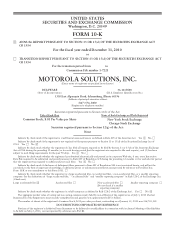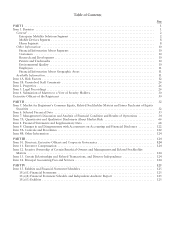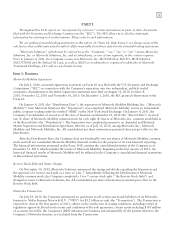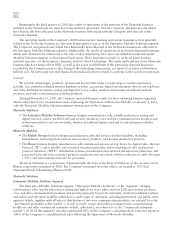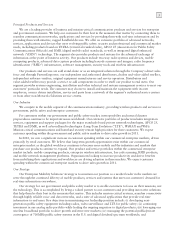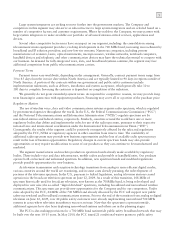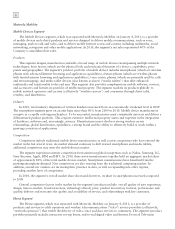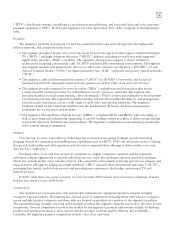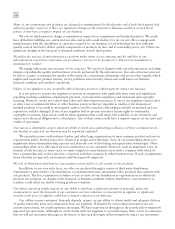Motorola 2010 Annual Report Download - page 17
Download and view the complete annual report
Please find page 17 of the 2010 Motorola annual report below. You can navigate through the pages in the report by either clicking on the pages listed below, or by using the keyword search tool below to find specific information within the annual report.
9
(“IPTV”) distribution systems, broadband access infrastructure platforms, and associated data and voice customer
premises equipment (“CPE”). In 2010, the segment’s net sales represented 19% of the Company’s consolidated net
sales.
Products
The segment’s products and services are used by content providers and network operators throughout the
delivery network, and consumers in the home.
• The segment provides a broad array of set-top boxes for network operators that support standard definition
TV (“SDTV”) and high definition television (“HDTV”) delivery, including set-top boxes with integrated
digital video recorder (“DVR”) capability. The segment’s set-top boxes support a variety of delivery
architectures including conventional cable TV, IPTV and hybrid IP/conventional environments. The segment
also supplies modems and gateways for data over cable service interface specification (“DOCSIS”) 3.0 and
Optical Terminal Nodes (“OTNs”) for digital subscriber line (“DSL”) networks and passive optical networks
(“PON”).
• The segment’s cable modem termination systems (“CMTS”) for DOCSIS 3.0 networks and its optical
headend and network equipment enable network operators to deliver video, data and voice services.
• The segment provides integrated receiver decoders (“IRDs”), multiplexers and transcoders that receive
content from the content providers for redistribution over the operators’ networks. The segment also
provides encoders for local programming, video-on-demand (“VOD”) servers and multiplexers for placement
of advertising streams. The segment’s portfolio includes software that enables the delivery and management
of multi-screen experiences across a wide range of cable, telco and wireless platforms. The segment’s
products include security solutions used between the headend and the home and device management
technology for set-top boxes and modems.
• The segment’s Moving Picture Experts Group (“MPEG”)-compliant SDTV and HDTV video encoding, as
well as processing and multiplexing equipment, is used by leading content providers to deliver programming
to network operators’ headends and central offices. The segment’s conditional access technology secures the
video content during transmission.
Industry
Over the last 15 years, video delivery technology has converted from analog to digital, greatly increasing
program choices for consumers and enabling new capabilities such as HDTV, VOD and interactive services. During
this period, both traditional cable operators and telcos have expanded their offerings to deliver video, voice and
data services (“triple play”).
Providing video, voice and data services to consumers is a highly competitive business and the segment’s
customers compete aggressively to provide individual services, triple play packages and even quad play packages,
which also include mobile voice and data services. The competitive environment is driving operators to enhance and
expand service offerings by adding more high definition (“HD”) channels, three dimensional television (“3D-TV”),
increasing data speeds, mobile data services and providing new experiences that bridge conventional TV and
Internet services.
In 2010, while there was some economic recovery from the 2009 adverse macroeconomic conditions, demand
had not yet returned to pre-2009 levels.
Competition
The segment’s set-top boxes and cable and wireline infrastructure equipment products compete in highly
competitive global markets. The segment has a broad array of competitors including those with whom it competes
across multiple product categories and those who are focused on products in a portion of the segment’s portfolio.
The rapid technology changes occurring in the markets in which this segment competes may lead to the entry of new
competitors. General competitive factors in the market for the segment’s products and systems include: technology;
product and system performance; price; time-to-market; product features; quality; delivery and availability.
Currently, the segment’s primary competitors include Cisco, Pace and Arris.


